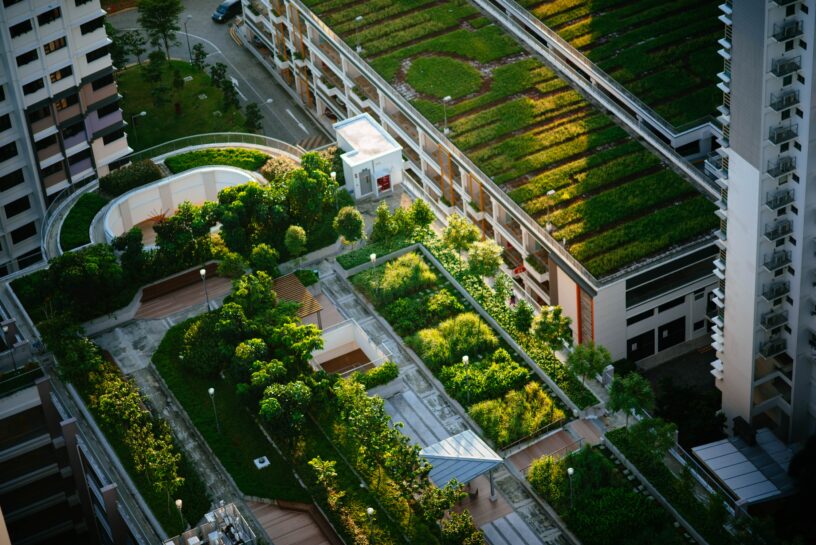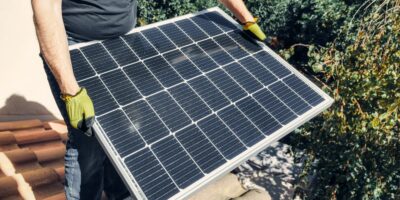Introduction
When it comes to finding sustainable and efficient energy sources, it’s important to explore all options. Passive solar energy is one such option, and it’s been gaining popularity in recent years. But what exactly is passive solar energy?
Explanation of Passive Solar Energy
Passive solar energy refers to using the sun’s energy for heating and lighting without mechanical or electrical equipment. Unlike active solar systems requiring expensive equipment like photovoltaic panels or pumps, passive solar systems rely on natural design elements like orientation, insulation, and thermal mass.
In short, passive solar design is all about maximizing the power of sunlight to provide heat and light within a building. This can be done by carefully placing windows, walls, floors, roofs, and other materials to absorb sunlight during winter while minimizing summer heat gain.
Benefits of Using Passive Solar Energy
The passive solar design offers numerous benefits compared to traditional heating and lighting methods. For one thing, it is a completely renewable source of energy that doesn’t contribute to greenhouse gas emissions or environmental pollution. Furthermore, because passive solar designs are based on natural principles rather than complex machinery or electrical components, they are often more affordable than conventional heating systems in the long run.
Moreover, they require very little maintenance as well. Additionally, homes that utilize passive solar designs tend to be more comfortable throughout the year due to their ability to regulate temperature without relying on artificial means.
This means less reliance on air conditioning units during hot summers and reduced utility bills overall. Overall, if you are seeking an effective way to harness natural resources for your home’s comfort – with minimal impact on your wallet or environment – consider investing in passive solar technology!
How it Works
From Sunlight to Heat Energy
When sunlight enters a room, it can be absorbed by walls and floors. This absorbed energy is then converted into heat energy that can heat the interior of a building.
This process is called passive solar heating. The conversion of sunlight into heat energy occurs primarily due to the greenhouse effect.
The windows and walls of a building allow sunlight to enter, but they also trap some of the heat generated by this light. As this trapped heat accumulates, it raises the temperature inside the building.
The Role of Building Materials in Absorbing and Storing Heat
The materials used in a building’s construction play a major role in how well it can utilize passive solar heating. Materials with high thermal mass, such as concrete or brick, absorb and store heat energy effectively.
Once these materials have absorbed enough heat from the sun, they slowly release that stored energy back into the house over time. This allows for more consistent heating throughout the day and night.
The Importance of Orientation and Placement of Windows and Walls
To maximize passive solar heating, buildings must be designed carefully considering their orientation and placement of windows and walls. In general, south-facing windows receive more direct sunlight than north-facing ones – making them ideal for capturing solar energy.
Moreover, designing buildings with larger south-facing windows will also allow more sun to enter during winter months when there are fewer daylight hours. Additionally, overhangs or other shading devices can be installed on these windows to block out direct sunlight during summer when cooling is desired.
Strategic placement of walls within a building can also help distribute heat effectively. For example, placing higher thermal mass materials like brick or concrete on interior walls rather than exterior ones will help absorb more heat and distribute it evenly throughout the space.
Considering these design elements and building materials that absorb and store heat energy, it is possible to create buildings that utilize passive solar heating effectively. In the next section, we’ll discuss some specific design features that can help make this possible.
Designing for Passive Solar Energy
Passive solar energy can save money and reduce your carbon footprint, but it requires careful planning and design. There are several factors to consider when designing a building for passive solar energy. Here are some of the most important:
Location and Orientation
The location and orientation of your building are one of the most important factors in passive solar design. Buildings should ideally be located on south-facing slopes to maximize exposure to sunlight. The orientation of the building should also be carefully considered – windows should be placed on the south-facing side of the building to allow maximum sunlight during winter months.
Thermal Mass
Thermal mass refers to materials that absorb and store heat, such as brick, concrete, or stone. Buildings with high thermal mass can help regulate temperature by absorbing heat during the day and releasing it at night. This can help keep your home cool in summer and warm in winter.
Shading Devices
Shading devices such as awnings, overhangs, or shading screens can help reduce heat gain during summer months while allowing sunlight into your home during winter. These devices can also add aesthetic appeal to your home.
Insulation
Good insulation is crucial when designing a passive solar home. Insulation helps regulate temperature by preventing heat loss through walls, ceilings, and floors. High-quality insulation will also help reduce noise pollution from outside sources.
Building Materials
When designing a passive solar home, choosing materials that are effective at absorbing and storing heat energy while also being aesthetically pleasing is important. Brick veneer is a popular choice since it has good thermal mass properties while providing an attractive finish for walls. Designing a building for passive solar energy requires careful consideration of several factors.
The location and orientation of the building, the use of thermal mass, shading devices, insulation, and building materials all play an important role in creating an effective passive solar design. Considering these factors can help you create a home that is comfortable, environmentally friendly, and cost-effective in the long run.
Applications of Passive Solar Energy
Residential homes
Passive solar energy can be implemented in residential homes to provide cost-effective and environmentally friendly heating and cooling. In order to maximize sun exposure, the house should be oriented towards the south, with windows and walls strategically placed to absorb and store heat.
Thermal mass materials such as brick or concrete can be used to store this heat during the day, releasing it slowly at night when temperatures drop. Various features can also be added to a home to increase its effectiveness in utilizing passive solar energy.
For instance, shading devices like overhangs or trellises can protect against excessive heat gain during the summer months. Insulation is also crucial for maintaining a consistent temperature inside the house.
Some homeowners may combine passive solar energy with other renewable energy sources, such as solar panels or wind turbines, for even greater efficiency. Additionally, government incentives like tax credits or rebates may be available for installing these systems.
Commercial buildings
Large commercial buildings can benefit greatly from implementing passive solar energy strategies into their design plans. These buildings can significantly reduce their dependence on traditional heating and cooling systems by incorporating thermal mass materials and maximizing sun exposure through window placement and orientation.
Furthermore, green roofs and walls are becoming increasingly popular in commercial building design due to their ability to absorb sunlight and reduce overall energy usage. These features also serve as natural insulation by providing an additional layer between the outside environment and the building’s interior.
In addition to environmental benefits, implementing passive solar strategies into commercial buildings has economic advantages. Lower energy costs translate into lower operating costs for businesses over time.
Agricultural applications
Passive solar techniques are not limited solely to residential or commercial buildings; they can also be applied in agricultural settings. Greenhouses are a prime example of how passive solar energy can create optimal growing conditions for plants year-round. Greenhouses can maintain consistent temperatures throughout the day and night by using thermal mass materials and maximizing sun exposure.
Additionally, shading devices and ventilation systems can be implemented to regulate temperature and humidity levels. Passive solar energy can also be used in irrigation systems for farms.
Solar-powered pumps or water heaters are a cost-effective alternative to traditional electric-powered systems. This reduces the overall operating costs of the farm while minimizing its carbon footprint.
Conclusion
Passive solar energy is a versatile and cost-effective solution for heating, cooling, and other energy needs in various settings. From residential homes to commercial buildings to agricultural applications, implementing passive solar strategies can result in lower operating costs and an overall reduced environmental impact. With government incentives available worldwide, there has never been a better time for individuals or businesses to explore the possibilities of passive solar energy.
Advantages and Disadvantages
Advantages
Passive solar energy is a great alternative to traditional heating and cooling systems for several reasons. First, it is cost-effective.
Passive solar design can be incorporated into new building construction or retrofitted into existing structures at a lower cost than installing an active solar energy system. Once installed, passive systems require little maintenance, reducing long-term costs.
Secondly, passive solar energy is environmentally friendly. Using the sun’s energy as the primary heat source reduces dependence on non-renewable resources such as coal and oil that contribute to air pollution and greenhouse gas emissions.
Passive solar design can also improve indoor air quality by reducing the need for mechanical ventilation systems. This is because natural ventilation sources, such as operable windows and skylights, are incorporated into the design.
Disadvantages
While there are many advantages to using passive solar energy, there are also some limitations to consider. One major disadvantage of passive solar design is its limited effectiveness in certain climates.
Passive systems work best in areas with abundant sunshine throughout the year. In northern climates with limited sunlight during winter months, additional heating systems may be needed to supplement passive heating methods.
Another potential disadvantage of passive solar is that it may require additional cooling systems in hot climates where excessive heat gain can occur within buildings. This could offset any potential savings from heating costs.
Effective passive solar implementation requires careful planning and consideration during building design or retrofitting. A poorly designed system can lead to inefficient use of sunlight or inconsistent temperatures within a building.
It’s also important to note that not all buildings are suitable for incorporating passive solar components due to factors such as building orientation and shading from surrounding structures or landscape features. Despite these limitations, implementing a well-designed passive solar system has proven benefits in reducing energy consumption and lowering carbon emissions.
Conclusion
Summary of key points
Passive solar energy is a cost-effective and environmentally friendly alternative to traditional heating and cooling systems. It works by harnessing the power of sunlight to convert it into heat energy through building design and materials. This can be accomplished by properly orienting windows, walls, and other features to maximize sun exposure and by using materials with high thermal mass.
Designing a building for passive solar energy requires careful consideration of factors such as location, climate, and building orientation. Examples of passive solar design features include thermal mass, shading devices, and insulation.
Passive solar energy has many applications in residential homes, commercial buildings, and agricultural operations. Its benefits include lower energy bills, reduced carbon emissions, and improved indoor air quality.
Future potential for passive solar energy
The future potential for passive solar energy is bright. As technology advances and awareness of the importance of sustainable living grows, more people are turning to passive solar solutions for their homes and businesses. In particular, there is significant potential for growth in developing countries where access to traditional heating systems may be limited or non-existent.
Passive solar technology can help these communities reduce their reliance on non-renewable resources while improving their living standards. Additionally, as the effects of climate change become more apparent, governments around the world are taking steps to promote renewable energy sources like passive solar.
Some countries offer tax incentives or other subsidies for homeowners who install passive solar systems in their homes. Overall, the future looks bright for passive solar energy as we strive toward a more sustainable future.



